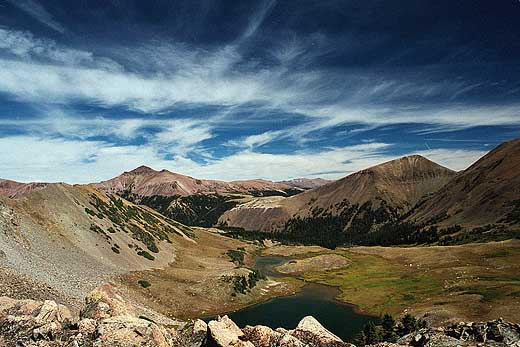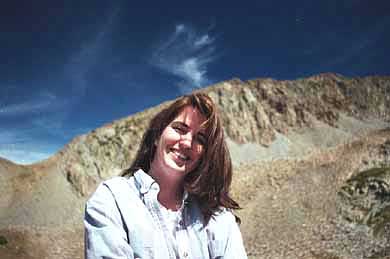
AMERICAN LAKES
(Michigan Lakes)
Andra, Frank and I took a leisurely stroll up to the two lakes called the American Lakes in late September 2000. The terminology is confusing. One of the lakes is also known as Snow Lake, so really there is only one American Lake. The Colorado State Forest also calls them the Michigan Lakes, despite the fact that Michigan Lake is up the road about 10 miles. Who knows? Who cares? What we call the lakes is of no importance to anyone as we crunch the gravel of the trail under stiff-soled hiking boots.



 The
upper lake is much higher than the lower one, and is a strenuous hike to
reach. Andra decides to remain by the lower lake and read while I take
a quick trip up with Frank. The upper lake is barren, completely lacking
in plant life of any kind. It's shores are a maze of sharp rocks and boulders,
unstable and wobbly underfoot. While seated at its shores, no green is
visible. The only sign of life is the profusion of lichens attached tenaciously
to the rocks, and two talkative ravens hoarsely cawing from the cliffs
on the far shore. These cliffs are the Nokhu Crags, a splendid formation
consisting of sharp, unwholesomely barren and jagged pinnacles pointing
sharply toward the sky. From the upper lake's shores, they are but a few
hunderd feet above me, and I consider trying to make it to the top. For
on the other side, over a thousand feet below, are the deep blue waters
of Lake Agnes. In the end, I opt to merely
sit and listen to the brisk wind howl among the rocks.
The
upper lake is much higher than the lower one, and is a strenuous hike to
reach. Andra decides to remain by the lower lake and read while I take
a quick trip up with Frank. The upper lake is barren, completely lacking
in plant life of any kind. It's shores are a maze of sharp rocks and boulders,
unstable and wobbly underfoot. While seated at its shores, no green is
visible. The only sign of life is the profusion of lichens attached tenaciously
to the rocks, and two talkative ravens hoarsely cawing from the cliffs
on the far shore. These cliffs are the Nokhu Crags, a splendid formation
consisting of sharp, unwholesomely barren and jagged pinnacles pointing
sharply toward the sky. From the upper lake's shores, they are but a few
hunderd feet above me, and I consider trying to make it to the top. For
on the other side, over a thousand feet below, are the deep blue waters
of Lake Agnes. In the end, I opt to merely
sit and listen to the brisk wind howl among the rocks.
Frankie watches the water ripple, and seems very content to be a dog on this day. Dogs need a life, and Frank lives well, I think. Back at the lower lake some time later, Andra and I throw rocks for Frankie to chase, a favorite activity sinse frisbee became off-limits. Andra finds a thick stick and tosses it just into the lake. Frank cautiously walks in, then goes completely under as he falls off the shelf and into the deep abyss. He spastically splashes his way to the stick and executes a tight u-turn in mid water before paddling back to shore. We throw the stick a few more times, and he seems to enjoy the swimming. His short hair dries quickly on the walk back, although for him the walk back is a constant state of loping along in the wind-blown grass, searching for uncatchable critters.


One week after we hiked this trail, it was buried under
snow for the winter.
